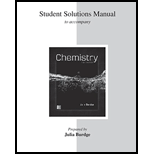
Concept explainers
Interpretation:
The minimum voltage required to produce one mole of aluminum at the temperature at which aluminum produced by the Hall process and the energy required to produce
of the metal is to be calculated.
Concept Introduction:
The Hall–Heroult process is considered an enormous industrial process in which the smelting of aluminum takes place.
The decomposition of chemical process takes place by the electrolytic cell that contains electrical energy.
The number of moles can be calculated as:
The relationship between cell voltage and free energy difference is represented as:
Answer to Problem 49QP
Solution:
(a) The minimum voltage required to produce one mole of aluminum is
(b) The energy required to produce
of the metal is
Explanation of Solution
Given information: The overall reaction for the electrolytic production of aluminum by the Hall process is represented as:
At
a) The minimum voltage required to produce
The relationship between cell voltage and free energy difference is represented as:
Here,
All the given values are to be put in the formula as:
Aluminum contains two moles in the balanced equation so, the whole given equation is divided by two.
Thus, the new equation is as
For the new equation,
The Gibbs energy is calculated as
These values are put in the formula as
Hence, the required voltage would be the same, whether one mole or
b) The energy required to produce 1.00 kg of the metal.
Primarily,
change into moles takes place.
The electrical energy can be found by using the same formula taking other voltage as
The electrical work can be obtained by the multiplication of the voltage and the amount of charge transported through the circuit as
Want to see more full solutions like this?
Chapter 23 Solutions
Student Solutions Manual for Chemistry
 ChemistryChemistryISBN:9781305957404Author:Steven S. Zumdahl, Susan A. Zumdahl, Donald J. DeCostePublisher:Cengage Learning
ChemistryChemistryISBN:9781305957404Author:Steven S. Zumdahl, Susan A. Zumdahl, Donald J. DeCostePublisher:Cengage Learning ChemistryChemistryISBN:9781259911156Author:Raymond Chang Dr., Jason Overby ProfessorPublisher:McGraw-Hill Education
ChemistryChemistryISBN:9781259911156Author:Raymond Chang Dr., Jason Overby ProfessorPublisher:McGraw-Hill Education Principles of Instrumental AnalysisChemistryISBN:9781305577213Author:Douglas A. Skoog, F. James Holler, Stanley R. CrouchPublisher:Cengage Learning
Principles of Instrumental AnalysisChemistryISBN:9781305577213Author:Douglas A. Skoog, F. James Holler, Stanley R. CrouchPublisher:Cengage Learning Organic ChemistryChemistryISBN:9780078021558Author:Janice Gorzynski Smith Dr.Publisher:McGraw-Hill Education
Organic ChemistryChemistryISBN:9780078021558Author:Janice Gorzynski Smith Dr.Publisher:McGraw-Hill Education Chemistry: Principles and ReactionsChemistryISBN:9781305079373Author:William L. Masterton, Cecile N. HurleyPublisher:Cengage Learning
Chemistry: Principles and ReactionsChemistryISBN:9781305079373Author:William L. Masterton, Cecile N. HurleyPublisher:Cengage Learning Elementary Principles of Chemical Processes, Bind...ChemistryISBN:9781118431221Author:Richard M. Felder, Ronald W. Rousseau, Lisa G. BullardPublisher:WILEY
Elementary Principles of Chemical Processes, Bind...ChemistryISBN:9781118431221Author:Richard M. Felder, Ronald W. Rousseau, Lisa G. BullardPublisher:WILEY





